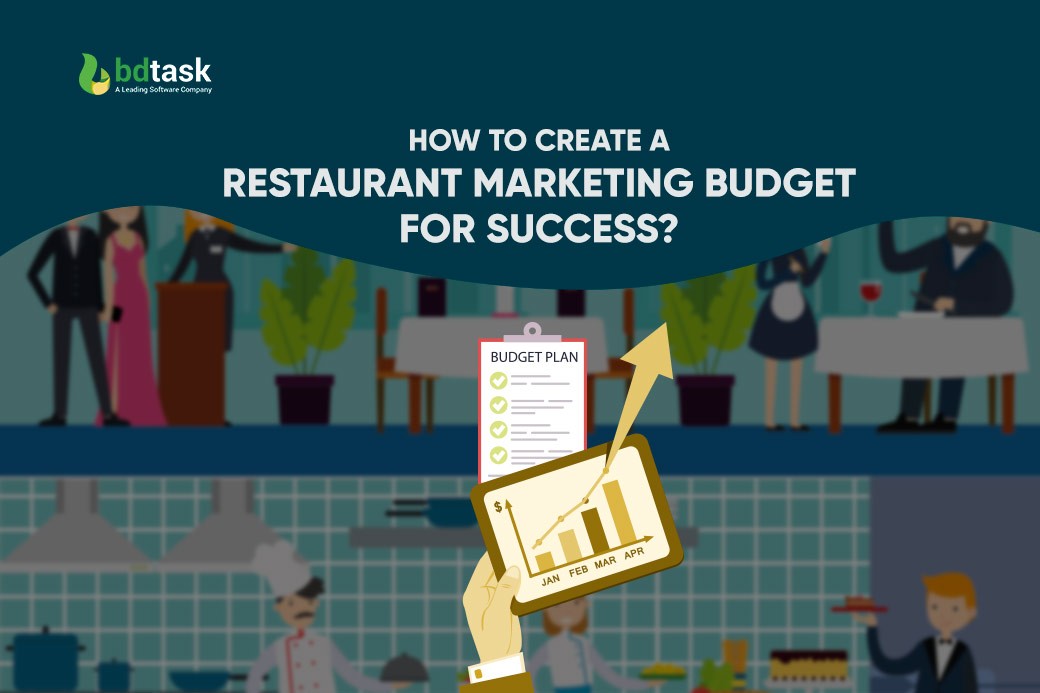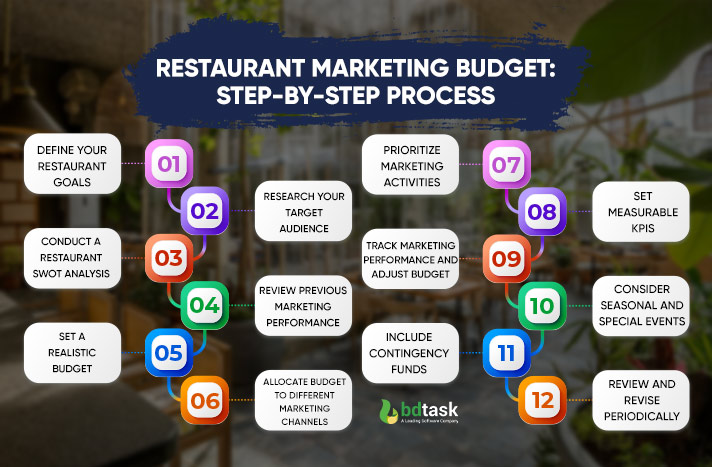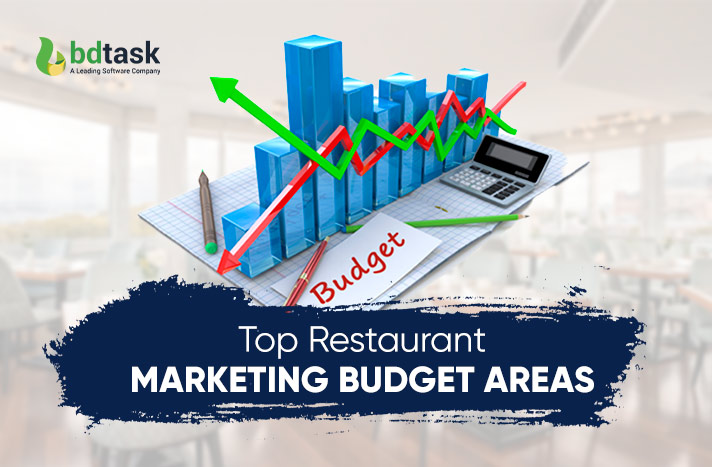How to Create a Restaurant Marketing Budget for Success?

A well-planned marketing is a vital element for running a business successfully. In the competitive restaurant industry, a restaurant business's success also depends on a strategic marketing plan. A perfect restaurant marketing budget helps to gain customers, create brand authority, and ensure long-term success. For every restaurant, the marketing budget is unique because the factors and business goals are different. In this blog, we will explore restaurant marketing budget breakdown, best restaurant marketing areas and many more.
What is Restaurant Marketing Budget?
Marketing involves different types of processes to identify what your customer wants and how to meet those needs. Restaurant marketing helps to create, communicate and deliver value to restaurant customers.
A restaurant marketing budget is a plan for how much money a restaurant will spend on marketing in a specific period. It clearly defines the spending amount of money for different types of marketing and advertising activities. The budget should be realistic and based on the restaurant's financial situation. A restaurant marketing budget is very important because it helps to make restaurant business operations successful and track expenses.
Restaurant marketing is a long-term business improvement plan, though it involves some short-term tasks. It is not the basic part of day-to-day restaurant operation. So, you can undoubtedly consider restaurant marketing as capital expenditure. Many consider their cost for instant results giving advertisement as an operational expense. But the advertisement does not give results parallelly while running. Restaurant advertisement ultimately helps to create brand awareness and reputation. So, any short-term advertisement is actually a part of the long-term marketing plan.
If you consider a marketing budget plan for restaurant as a capital expenditure, you do not have to worry much during the tough times. You can also maximize your budget according to the restaurant industry situation. Thus, creating a restaurant marketing cost plan needs a clear understanding of its expense nature.
Average Marketing Budget for Restaurant
For an existing restaurant, the restaurant marketing budget percentage should be a good percentage of its yearly revenue. As restaurant business is a B2C type, the average marketing budget for restaurant should be 6 to 14% of its annual sales. However, restaurant budgeting depends on many factors, like the size of the restaurant, type of restaurant and location of the restaurant.
For example, a small restaurant may only spend 2% of its sales on marketing. A large chain restaurant may spend 8% or more. A startup restaurant's primary focus is to reach more people. It may spend more on restaurant marketing than the average marketing budget.
So, there is no exact percentage amount of the total budget for restaurant marketing. Every restaurant should spend based on its own needs and business target.
Restaurant Marketing Budget: Step-by-step Process

Every restaurant has its own unique condition. So, for an effective marketing budget plan for restaurant, the motivated restaurant owner or manager must carefully consider all the necessary factors. You must also carefully plan and consider the essential factors to create a successful restaurant marketing budget.
Here is a step-by-step guide for creating the best restaurant marketing budget:
1. Define Your Restaurant Goals
Before creating any budget plan, it is necessary to define goals and objectives. You should also determine what you want to achieve with your marketing efforts. This could include increasing brand awareness, attracting new customers, boosting sales, or promoting a special event. You should clearly define your marketing goal. You can define short and long-term goals. You should also create clear objectives to reach every financial goal.
You must develop an effective restaurant marketing strategy to align with your goal. You should consider the seven Marketing Mixes for your restaurant marketing plan. These are 7Ps:
Product - Your food offerings;
Price - Food and reservation price;
Placement - Restaurant location;
Promotion - Marketing plan;
People - Your staff and customers;
Process - All operations like food supply and kitchen management; and
Physical Evidence - Your necessary license and restaurant environment.
There are more things included in these marketing mix areas. It will be best to consider them all for the best result. Your restaurants can make money if you set the goal perfectly and then follow the rest of the steps.
2. Research Your Target Audience
A well-defined customer selection helps to create a proper marketing plan. You should select the ideal customers for your restaurant. You should prioritize all segmentations like demographics, preferences, behaviours, and geographic location. This information will guide your marketing efforts.
3. Conduct a Restaurant SWOT Analysis
Like any other business, conducting a SWOT analysis for your restaurant is necessary. You should analyze your restaurant's Strengths, Weaknesses, Opportunities, and Threats. This will help identify areas where marketing efforts are needed. A properly conducted SWOT analysis will help to grow your restaurant. It will also help to create your marketing budget according to your growth plan.
4. Review Previous Marketing Performance
You should check your previous marketing plan if you have an existing restaurant business. You should evaluate past marketing campaigns to understand what worked and what didn't. Past marketing budgets and goals help to know how they were aligned. This previous data helps to refine your restaurant marketing strategies. It also helps to allocate resources effectively.
5. Set a Realistic Budget
Your restaurant marketing budget should be realistic. You should always allocate marketing budget for a restaurant without compromising other essential expenses. The budget should reflect your restaurant revenue, profit margins, and business goals. A realistic budget helps to create and achieve a realistic marketing plan. Your restaurants can be profitable if your marketing budget plan is perfectly set up and executed.
You can follow popular budget planning methods like the 70-20-10 rule. That means you can use 70% of your budget for a restaurant operation, 20% for any loan repayments and 10% for savings. Cut your marketing budget from that 70% and use it for branding, promotion and other purposes.
You can also apply that 70-20-10 rule for the marketing budget. You can use 70% of the marketing budget that already works for you because that already gives you a better ROI. Then, use the 20% budget on previously used marketing methods and the 10% for the first-time method implication.
You can also use restaurant budgeting software like YNAB, Goodbudget, Quicken, EveryDollar, Xero and QuickBooks. But for the start, it is better to use Google Sheets. It is free to use and has enough features to do a perfect costing calculation and create a budget plan for your restaurant. Moreover, you can share budget planning online with your business partners, or budget execution plans with restaurant employees using Google Sheets. Another popular tool for budget-making is Microsoft Excel. You can input all historical data and forecast your restaurant marketing budget in this application.
6. Allocate Budget to Different Marketing Channels
You should allocate your restaurant marketing budget to different marketing channels. A proper marketing channel can be enough if you can utilize it properly. You have to identify how you can reach most of your target market. You can then focus your marketing efforts accordingly to reach them. There are many marketing channels, such as digital, traditional, and public relations. We will explore more about these marketing channels in the next blog section.
7. Prioritize Marketing Activities
There are many activities involved in reaching a restaurant business goal. You have to determine which activities are most critical for achieving your goals. For example, if you have a new restaurant, you must allocate more marketing budget for your restaurant to build brand awareness. If you are running a successful restaurant business, you can focus on budgeting for the next big event.
8. Set Measurable KPIs (Key Performance Indicators)
For any business, it is necessary to have measurable key performance indicators (KPIs). You should define specific metrics to track the effectiveness of your restaurant marketing efforts. This could include metrics like website traffic, social media engagement, conversion rates, and customer acquisition costs. For example, your first month's website visitor target is 20,000 with paid ads, and the conversion rate target is 10% from these visitors.
9. Track Marketing Performance and Adjust Budget
One of the most essential budgeting steps is regularly tracking the restaurant's marketing performance. You should evaluate your marketing campaigns against the defined KPIs. If the campaign result is different than expected, be ready to update it. You should change focus on marketing channels or strategies according to the running campaigns. Organize all your campaign data to create or adjust your new marketing budget.
10. Consider Seasonal and Special Events
Seasonal and special events help to boost restaurant success. You should pick this opportunity and include it in your marketing plan. You should not hesitate to promote your restaurant whenever you get a chance. You should allocate a handsome budget for holiday promotions or seasonal campaigns. This type of campaign has a trend to get more customers. So, while creating your restaurant marketing calendar, take this step seriously.
11. Include Contingency Funds
A contingency fund is one of the most important steps of a restaurant marketing budget. There are many hidden or sudden expenses in a business operation. You should keep a budget for these unforeseen expenses. Many opportunities for restaurant promotion may arise during the year. If you know the hidden costs, you can take new marketing opportunities. You do not have to adjust or change your running cost if you already have contingency funds.
12. Review and Revise Periodically
No matter how perfect your restaurant marketing plan is, you should review it periodically. A periodic review of your marketing budget ensures the alignment of your goals and return on investment. The ROI calculation helps to consider any changes in your business environment. For example, if the ROI is better for influencer marketing, you can increase the budget for this marketing channel. Suppose Google advertising is not working for your local restaurant. In that case, you can evaluate your ads to readjust them with new creatives and refined targeting.
Top 10 Restaurant Marketing Budget Areas

If you want to maximize your ROI, you must allocate your restaurant marketing budget effectively. There are many marketing areas or channels that you can use for branding, promoting and ultimately making profits. You can try many channels at a time or focus on at least one, depending on your marketing strategy and business goal.
Here are the major restaurant marketing budget areas:
1. Online Advertising
Online advertising can help to reach diners everywhere. In today's digital age, online advertising is key to restaurant success. Platforms like Google Ads and Facebook offer powerful tools to target potential customers.
According to a survey, almost 80% of respondents are likely to visit a restaurant's website before dining in, ordering takeout, or delivery.
Your restaurant can appear at the top of relevant search results if you know how to use online marketing. It ensures visibility when potential diners are actively looking for a place to eat. So, keep a good amount for the restaurant advertising budget.
2. Social Media Marketing
You can build a community of food enthusiasts through social media marketing. Social media is a great tool for people looking for dining recommendations.
Most diners (over 50%) said that they were influenced by a restaurant's social media content when deciding where to eat.
You can use Facebook, Instagram, TikTok and other popular social media to visually showcase your restaurant's ambience, dishes, and special events. You can share engaging posts, such as high-quality images of signature dishes or behind-the-scenes glimpses of the kitchen. To efficiently manage these posts, it's crucial to schedule social media posts, ensuring consistent engagement with your audience. It can attract potential customers to visit. You can collaborate with social media Influencers. It helps to reach a broad audience faster. So, have a budget for social media marketing strategy.
3. Search Engine Optimization (SEO)
Nowadays, people have many options when choosing a restaurant. So, it is important to be on top of people's choices. If you have a restaurant website, that's good. But it is also important that potential customers can find it. SEO helps to rank higher in search engine results by optimizing your restaurant website. This is achieved through strategies like using relevant keywords, for example - "best pizza restaurant in new york city", providing high-quality, informative content, schema markup and more.
Almost 70% of online experiences begin with a search engine.
We can understand the significance of a strong SEO strategy from this. So, you should allocate marketing budget for a restaurant for effective SEO tasks.
4. Email Marketing
Email marketing is a cost-saving and effective way to stay in your customer's inbox. It is a powerful tool for building and nurturing customer relationships. You should send regular emails with updates on special offers, menu changes, and upcoming events to keep your restaurant top-of-mind or implement an AI email writer in your workflow to automate the writing process.
The average return on investment (ROI) of the restaurant industry for email marketing is more than $30 for every $1 spent.
This highlights the potential for a high return on investment when executed effectively. So, always pay attention to email marketing while allocating your budget for restaurant marketing.
5. Website Development and Maintenance
A well-designed restaurant website is a digital storefront for your customers. It should be easy to navigate, mobile-friendly, and visually appealing. You should ensure that your restaurant includes essential information like your menu, contact details, and high-quality images of your dishes. You can lose your potential customer if the website user experience is not good.
According to Zippia, a large percentage of users (57%) will not recommend a business with a poorly designed mobile website.
This is because a poorly designed mobile website can be difficult to use, frustrating, and even untrustworthy. As a result, businesses that have poorly designed mobile websites are likely to lose customers and revenue. This report emphasizes the importance of a well-maintained online presence. So, keep enough budget for the website development budget.
6. Content Creation
Content marketing is a great way to tell your restaurant's story. Engaging content allows your restaurant to showcase its unique qualities. You should regularly share stories about your chefs, the origins of your ingredients, and the inspiration behind your recipes. Short-form video content is becoming increasingly popular with platforms like YouTube and TikTok. You can create short videos to showcase the cooking process. It can be a very engaging factor. Creating informative and engaging videos can help your restaurant stand out in a crowded digital landscape. So, you should have a good amount of money for content creation.
7. Public Relations (PR)
You can put effort into public relations (PR). Building relationships with local media outlets can significantly increase your restaurant's visibility. You can send press releases about new menu items, charity events, or unique offerings. You can feature in newspapers, magazines, or blogs. This exposure can introduce your restaurant to a wider audience and enhance its credibility within the community. Customers feel more confident to visit your restaurant when they see your reputation. So, you should have a good percentage of the restaurant marketing budget for your PR strategy.
8. Social Events and Promotions
Social events and promotions help to create memorable experiences. Hosting special events and promotions in your restaurant is a great way to create buzz and draw in new customers. You can arrange themed nights, live music events, or seasonal promotions like "Happy Hour", "Summer Sale", and "Black Friday" to generate excitement. You can promote restaurant events on social media and email campaigns to reach your audience effectively. Many consumers are more likely to dine out during special promotions or events. So, budget for social events to get more traffic and revenue.
9. Loyalty Programs
Loyalty Programs are an effective way to increase customer retention. Your customers feel valued by the loyalty programs. You should arrange rewards for your loyal customers to encourage them to visit your restaurant more frequently. For example, offering a free dessert after every fifth meal can encourage customers to return. Oracle Hospitality found that 81% of consumers are likelier to choose a restaurant with a loyalty program. It indicates the potential impact on customer retention and revenue.
10. Local Community Engagement
Be the engaging neighbour of your local community. You should engage with the local community to strengthen your restaurant's reputation. You can sponsor and support community events. You can also partner with nearby businesses or host charity nights for local causes. People love socially responsible and community-focused businesses. So, consider this restaurant marketing cost for active participation in local initiatives. This will help your restaurant to attract socially-conscious diners and contribute to the greater good.
Conclusion
If you can create a restaurant marketing budget according to your unique goals and audience, you can reach one step ahead towards success. Every method of making a budget and using a budget is for getting more reach and engagement with diners. This ultimately drives more traffic and revenue. You should also make a better experience for your customers with meals and environment. Your restaurant marketing plan will help you to adapt to the ever-changing consumer preferences and industry trends. Make flexible and data-driven decisions to see the success you desire. You should be consistent with your restaurant marketing efforts. Take help from a marketing professional if needed. Evaluate your restaurant business journey and adjust your budget as needed. This way, you are budgeting for more than just success.
Happy budgeting for your restaurant marketing.
DISCLAIMER: This blog information is for general knowledge only. Bdtask does not endorse any specific business and guarantees the accuracy or completeness of content, including text, images, links, etc. No specific results are promised if you act on this advice. It is recommended to seek advice from a professional (like a lawyer, accountant, or business advisor) for situation-specific guidance.
Contents
- What is Restaurant Marketing Budget?
- Average Marketing Budget for Restaurant
- Restaurant Marketing Budget: Step-by-step Process
- 1. Define Your Restaurant Goals
- 2. Research Your Target Audience
- 3. Conduct a Restaurant SWOT Analysis
- 4. Review Previous Marketing Performance
- 5. Set a Realistic Budget
- 6. Allocate Budget to Different Marketing Channels
- 7. Prioritize Marketing Activities
- 8. Set Measurable KPIs (Key Performance Indicators)
- 9. Track Marketing Performance and Adjust Budget
- 10. Consider Seasonal and Special Events
- 11. Include Contingency Funds
- 12. Review and Revise Periodically
- Top 10 Restaurant Marketing Budget Areas
- Conclusion

Thinking Hassle Free
Software Development Service?
We provide custom software development services for business ERP solutions, blockchain, hospitality, e-commerce, e-learning & others.
Book AppointmentFor 30 Minutes Free Consultancy










